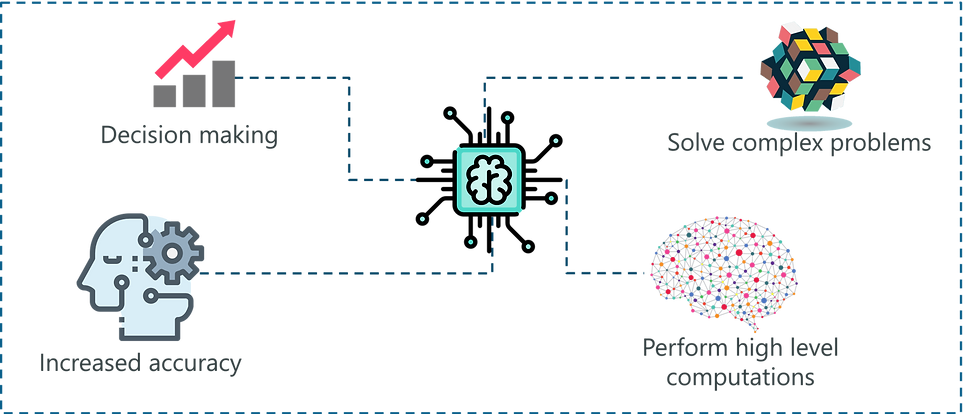4 Types of AI Explained (2025 Guide + Examples)
- Abhinand PS
.jpg/v1/fill/w_320,h_320/file.jpg)
- 6 hours ago
- 3 min read
Introduction: Understanding the Types of Artificial Intelligence
Artificial Intelligence (AI) is everywhere in 2025—powering chatbots, self-driving cars, recommendation engines, and even healthcare diagnostics. But AI isn’t a single technology; it’s a spectrum of capability and intelligence.

When people ask, “What are the 4 types of AI?” they’re usually referring to the standard classification used by researchers and industry leaders. These four categories help us understand how AI evolves from simple reactive systems to potentially self-aware machines.
Quick Overview: The 4 Types of AI
Type of AI | Definition | Real-World Example | Intelligence Level |
Reactive Machines | Basic AI that reacts to inputs but cannot learn from past data | IBM’s Deep Blue (Chess AI) | No memory; task-specific |
Limited Memory | AI that learns from historical data to improve decisions | Self-driving cars, Chatbots | Widely used in 2025 |
Theory of Mind | Hypothetical AI that understands human emotions and social context | Not yet fully developed | Future research stage |
Self-Aware AI | Advanced AI with its own consciousness and self-awareness | Not in existence | Theoretical, futuristic |
1. Reactive Machines – The Simplest AI
Reactive AI is the earliest and simplest form. These systems react to inputs but cannot learn or store past data.
🔹 Example: IBM’s Deep Blue, the chess-playing computer that beat Garry Kasparov in 1997. It analyzed moves but had no memory of past games.
In 2025, reactive AI is still used in simple automation tools, spam filters, and recommendation engines.
2. Limited Memory AI – Today’s Most Common AI
This is the most widely used AI in 2025. Limited Memory AI can store and learn from past data to make better predictions.
🔹 Examples:
Self-driving cars (using memory of previous trips to avoid accidents).
Virtual assistants like Siri or Alexa (remembering user preferences).
Chatbots & recommendation systems (improving based on feedback).
Most of the AI technologies shaping our daily lives are Limited Memory AI models—including large language models that power advanced chat systems.
3. Theory of Mind AI – The Next Frontier
Theory of Mind AI refers to machines that understand human emotions, beliefs, and intentions. While this concept remains experimental in 2025, researchers are working on empathetic AI assistants, social robots, and healthcare companions.
Example (conceptual): A healthcare robot that recognizes when a patient is sad and adjusts its tone.
Status: Still developing, not mainstream.
4. Self-Aware AI – The Future of Intelligence
Self-Aware AI is the most advanced and theoretical category. It describes AI that has human-like consciousness, emotions, and awareness of its existence.
This type does not exist in 2025, but it’s a subject of debate among experts in ethics, governance, and tech regulation.
Potential applications—if achieved—could revolutionize industries, but also raise questions about AI rights, responsibility, and safety.
Why Understanding AI Types Matters in 2025
Knowing the 4 types of AI is essential because it:
Helps businesses align expectations (most AI today is Limited Memory).
Guides policymakers in creating regulations for future developments.
Educates users about risks, limitations, and potential of AI evolution.
👉 Want to explore AI in real-world industries? Read our detailed guide on AI in Everyday Life at abhinandps.com.
FAQs on the 4 Types of AI
1. What are the 4 types of AI in simple terms?
They are Reactive Machines, Limited Memory, Theory of Mind, and Self-Aware AI. Today, most of the world runs on Limited Memory AI.
2. Which type of AI do we use today in 2025?
Almost all practical AI—like chatbots, self-driving cars, and recommendation systems—are Limited Memory AI.
3. Does Self-Aware AI exist?
No. Self-Aware AI is still theoretical and does not exist as of 2025. Experts estimate we may be decades away from achieving it.
Final Thoughts
So, what are the 4 types of AI?
Reactive Machines – Basic, no memory.
Limited Memory – Today’s dominant AI.
Theory of Mind – Future of social/emotional AI.
Self-Aware – Still a vision for the future.
By understanding these stages, businesses, governments, and individuals can better prepare for how AI will continue to transform life in 2025 and beyond.
👉 For deeper insights on AI and technology, check out our latest articles on AI & Tech Guides at abhinandps.com.



Comments